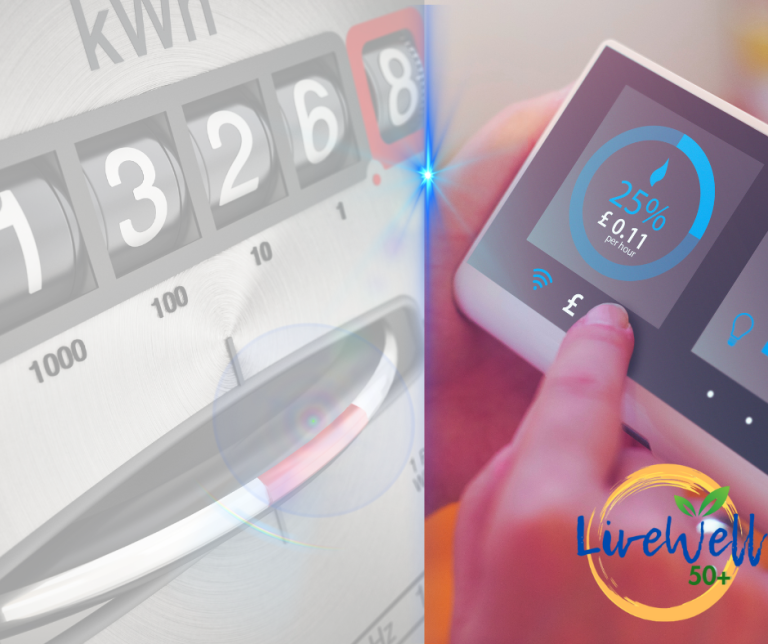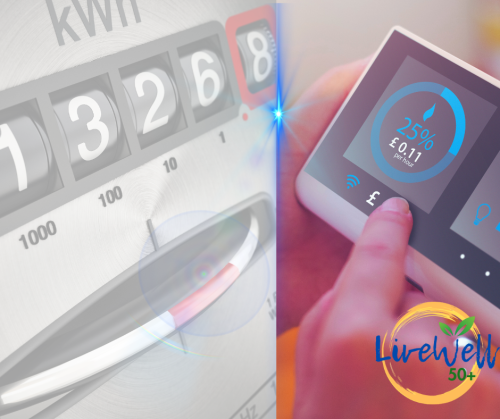Energy Savings for Seniors UK June 25

Read on to find out about energy sector changes that may affect you in the coming months.
Changes to the Energy Price Cap
The Energy Price Cap is the maximum an energy supplier can charge a user. It is calculated per each unit of energy per kilowatt hour (kWh) plus the daily standing charge. It is only applicable if you are on a default or standard variable tariff. The rates on this type of tariff change every 3 months along with the price cap. People are usually on these tariffs if they haven’t actively switched. Or they may have previously had a fixed price deal but haven’t chosen to switch since it ran out.
The cap doesn’t apply to current fixed-term energy tariffs. Fixed term tariffs are where you pay the same set amount per kWh for the length of your contract.
In detail;
- From the 1st July 2025 up until the 30th September 2025 the cap is set at £1,720 for a typical household who pay by direct debit.
- From April to the end of June its was £1,849, which means a decrease of 7% in July-September.
- The price cap is available for households who pay for gas and electricity by either; Direct Debit, Pre-Payment Meter, Standard Credit (i.e. pay on receipt of bill), or Economy 7 (E7) meter
According to Ofgem (The Office of Gas and Electricity Markets), the cap is based on typical household energy use (THU). The cap is set by Ofgem every 3 months. The Typical Domestic Consumption Values (TDCVs) are calculated using different household types alongside network and wholesale costs. This is then categorised by household size and occupancy into low, medium and high energy use. The typical household use (average of the three categories) for direct debit payers is then used to calculate the price cap.
At present THU is 2,700kWh of electricity and 11,500 kWh for gas per year per household. The cap per unit from July 1st 2025 until 30th September 2025 are as follows;
- Electricity is capped at 25.73 pence per kWh. The daily standing charge is capped at 51.37 pence
- Gas is capped at 6.33 pence per kWh. The daily standing charge is capped at 29.82 pence and is charged regardless of whether you have used any energy that day.
- Economy 7 or multi rate users may have more than one unit rate shown on their bill (due to different rates for peak and off-peak use).
How Does the Price Cap Affect My Bill?
Suppliers can charge differing amounts for unit rates and standing charges, however they cannot go over the cap. This means that on your bill your unit rate could be higher and your standing charge lower.
Please be aware that it is the unit rate that is capped, NOT the actual bill. If you use more you pay more. The actual price you pay for your energy on a standard variable tariff is determined by your location. It will vary according to how much energy you use.
For a detailed breakdown of the charges by area and payment type (DD, Standard Credit, PPM) see the Ofgem Website.
Should You Choose a Fixed Tariff?
Suppliers may try and tempt consumers onto a cheaper fixed tariff to ‘beat’ any future price energy cap price hikes. In principle, you could save money this way. However, there is no guarantee that even if the tariff is cheaper than the current cap at sign up, that it will remain cheaper following the next cap. Potentially you could end up paying more for your energy over the course of the year (or less). It is always worth viewing the energy cap predictions for the year ahead before signing up to any fixed deals. Money Saving Expert has recently published a table from energy experts Cornwall Insight detailing price cap predictions for some of the main suppliers for the year ahead.
It is also important to note that switching whilst in an agreed fixed term can incur early exit fees. You can usually change supplier without paying an exit fee if you have 49 days or less left on your contract (unless you have accrued arrears). You are only able to switch supplier if you have energy arrears of less then 28 days (or haven’t been sent a bill (CAB).
There are many tariffs available so it is always best to check the Ofgem website for accredited energy price comparison websites. Supplier tariffs will vary so compare a few before making any decision.
Priority Service Register
All energy suppliers in the UK have signed up to the PSR Promise (Priority Services Register). This means that they are obligated to provide extra support to customers who are vulnerable or need extra help due to age, disability, illness or other circumstance. Signing up with your supplier means you get priority support during emergencies, extra help with meter reads, and advanced notice if there is going to be a power cut. You can find more information at Ofgem.
RTS Meters (Radio Teleswitch Service Meters)
Also known as Dynamic Teleswitch Meters (DTS), these meters use radio signals to switch between different electricity tariffs e.g. between peak and off-peak rates. The signal is due to be switched off in a phased programme. This will begin June 30th 2025.
Affected customers will need to switch to Smart Meters to avoid disruption to their heating and hot water service. Smart meters will ensure customers continue to receive the correct peak and off-peak rates. If you have an RTS/DTS meter your supplier should be contacting you to arrange the switch. If you haven’t heard from them by now, it is vital you contact them to arrange an upgrade. The issues that could occur for those still on an RTA meter after 30th June 2025 are;
- If you have an RTS meter, up until now the RTS signal has been used to control when your hot water and storage heaters warm up. It turns them on when rates are cheaper (off peak) and switches them off when the rate is more expensive (peak). Once the signal is turned off your meter won’t work properly so heating and hot water could be continually on or off, or warming up at the wrong time.
- You could be charged incorrectly. RTS tells your supplier when you have used your electricity. Once the signal is turned off you could potentially be billed incorrectly for off-peak and peak usage.
- As the service is being switched off, there will be fewer tariffs being offered for those with an RTS meter (or possibly none at all).
For further information on how to identify if you have an RTS/DTS meter, how to contact your supplier, and what happens if a Smart meter can’t be fitted, see the Ofgem website link here.
Winter Fuel Payment
In 2024 the UK Government backtracked on their Winter Fuel Payment (WFP) scheme. The new rules meant that only those in receipt of Pension Credit or other means tested benefits would be eligible. In a much-welcome turnaround they have now announced that over three quarters of pensioners will be eligible for a payment for the winter 25/26 period (for further details on Pension Credit see Gov.uk).
The eligibility criteria is; individuals reaching State Retirement age by the qualifying week, which is the 15th to the 21st September 2025. They must also have an income of below £35K per year.
All pensioners will receive a payment of at least £100 per person, even if they are not in receipt of a means tested benefit.
The household financial gain for pensioners claiming a means tested benefit between State Pension age and 79 years is:
- £200, or £300 for those 80 and above (this applies to individuals living alone or in a care home).
Couples not in receipt of a means tested benefit will receive a shared payment.
- This equates to £200 per couple (£100 each) if both of you are over state pension age, and £300 per couple (£150 each) if you are both over state pension age and at least one of you is over 80.
It gets more complicated if there is a mixture of Pension Credit and non-Pension Credit claimants.
- Those claiming PC are paid in line with the entitlements above.
- For those individuals NOT claiming Pension Credit, they are paid at least £100 each or £150 if they’re 80+ and there are other people 80+ in the household, OR £200 if they’re the only person 80+ in the household – so for example, if a husband and wife both aged between 66 and 79 and not claiming PC lived with her elderly father 80+ they would receive a household payment of £100+£100+£200=£400. – If they all claimed pension credit this would increase to £500 (£200 per couple and £300 for PC claimant over 80) – OR if two sisters aged 66-79 lived together and one claimed pension credit and one didn’t, they would be paid £200+£100=£300.
For further examples Money Saving Expert has a detailed run down.
You can also see the full rates for the Winter Fuel Payment on the Gov.UK website. Or at Turn2Us.
Any pensioner who receives an annual income of over £35K will automatically have this payment recovered via PAYE or their Self-Assessment tax return. The £35K is based on individual income which means that household receiving 2 incomes of less than £35K per year will still be eligible, or for another example if one pensioner earns over £35K and one earns under, they would be entitled to a £100 or £150 payment (depending on their age) but their partner would not.
Winter Fuel Payment is also available to pensioners in Northen Ireland. For Scottish Pensioners there is a different scheme, The Pension Age Winter Heating Payment. Payments are usually made into your bank account between November and Christmas (2025).
If you haven’t received the payment by the 29th January 2026, contact the help centre: Telephone: 0800 731 0160, Textphone: Contact Relay UK on 18001 then 0800 731 0160.
Payments are made AUTOMATICALLY; you do not have to do anything. Please note that the Winter Fuel Payment is not included as income when calculating your entitlement to other benefits.
General Disclaimer:
The information on this blog site is for entertainment or informational purposes only and should not been seen as professional advice on the topic/subject contained in this article (including, but not limited to, medical, financial, health, nutritional, legal information). You rely on the information contained within at your own risk. Always consult with a professional in the subject area before taking action. This site may contain opinionated content – it doesn’t reflect the opinions of any organizations (if any) we might be affiliated with. Any information we provide on our blog is accurate and true to the best of our knowledge, but please note that on occasion there may be omissions, errors or mistakes. We reserve the right to change how we manage or run our blog. We may change the focus or content of this blog at any time.
FINANCIAL DISCLAIMER: THE INFORMATION ON THIS BLOG SITE IS NOT A SUBSTITUTE FOR PROFESSIONAL FINANCIAL SERVICES.
This website is not responsible for ANY action’s users take based on the site’s content. We are not recommending or endorsing any product, business or investment decision. Nor are we giving information specifically tailored to YOUR individual needs or situation. We do not have a financial or professional relationship with the reader. Always seek professional financial advice before entering into any financial or other agreement.
Related Posts

Reducing Cancer Risk In Older Adults
It is clear from the research that unhealthy lifestyle choices can lead to Cancer. Read on to find out how you can mitigate the risks.

Preventing Age Related Health Conditions
Read on to find out how you adopt healthy lifestyle choices to help prevent common age related conditions

